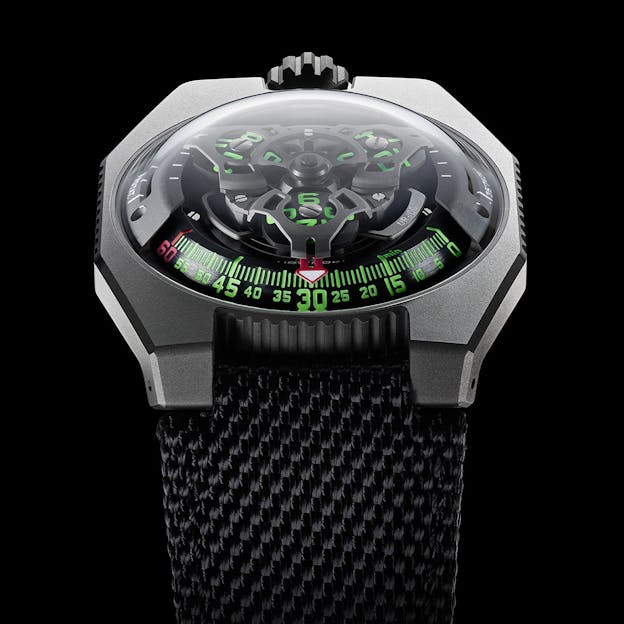Geneva Watch Days: The URWERK Space Time Blade
A Nixie tube-lit cutting edge spacetime clock.
If you bet on there being some unusual and even outlandish watches at Only Watch you are almost certainly going to win, except, of course, for the fact that no one who knows anything about the auction would take you up on your bet. Only Watch is a biennial benefit auction, which has been running since 2005 and which raises funds for research into improved therapies and, it’s hoped, an eventual cure for Duchenne muscular dystrophy.
There is a color theme for each year, and this year the theme was rainbows – some of the participating brands leaned hard into the theme while others opted for a more monochromatic approach. While URWERK’s contribution was not a rainbow-themed watch or clock per se, it was nonetheless one of the most unusual entrants – a five and a half foot tall (167 centimeters) glass tube, with eight of the glowing, neon-like display elements known as Nixie tubes, lined up vertically inside. The clock is inspired by the lightsabers from the Star Wars films but even in the Star Wars universe, I don’t think anyone has seen anything like this.

The Space Time Blade is a clock, but it’s also much more. There are several different display modes, controlled with a remote that also looks like the handle of a lightsaber, albeit it would have had to be constructed by a Jedi Knight (or maybe Sith Lord) with a taste for a distinctively steampunk aesthetic.

The clock can show, depending on which function you select, to show the time in hours, minutes and seconds; the same but with the addition of 1/10th and 1/100th of a second indications; the number of kilometers that the Earth has rotated at the equator since midnight; and the number of kilometers that the Earth has traveled in its orbit around the Sun, since midnight (the internal counters for both equatorial rotation and orbital distance reset to zero at midnight and the count starts over again). The Blade can be armed and disarmed by means of a long pin inserted into its base.

Those orbital functions have been used by URWERK before in its watches – the UR-100, specifically, which comes in several variations and which shows how far the Earth has traveled in its orbit, and the distance that it has rotated at the equator, over 20 minute periods (this is a secondary function of the time satellites which under ordinary circumstances, basically have no function until they rotate back into position in the actual wandering hours display).

The watch in turn, as well as of course the Space Time Blade, were inspired by a very unusual clock in URWERK’s Geneva offices, which I visited and saw for the first time in 2017. The clock was a gift to URWERK co-founder Felix Baumgartner from his father, and it was made by the French clockmaker Gustav Sandoz. Instead of showing the time, the clock shows the number of kilometers the Earth has rotated at the equator, over the course of a day (the pendulum has a period of 2.16 seconds which, at the equator, is equal to 500 meters). URWERK of course has a very long history of making wristwatches with very unusual time displays, generally based on the wandering hours system (although not always, they have produced some other watches, with different and out of the ordinary displays, as well.).
Nifty Nixies
The Nixie tube display is most fascinating to watch and for enthusiasts of a certain age (slowly raises hand) or just for fans of visually dramatic old school display technology, the Nixie tube is quite engrossing to watch in action.
A Nixie tube is a fairly straightforward piece of technology, related in principle to neon lights. The tube consists of a glass tube, which is filled at low pressure with an inert gas, like argon or neon. The tube can have different configurations; in the ones used for the Space Time clock, there is a wire mesh anode (an anode is the source of electrons entering the tube) and a number of cathodes, each in the shape of a different numeral. When current passes from the anode through one of the cathodes, it will produce a luminous orange discharge and for time displays, or really any count up or count down display, you can have cathodes in the shape of the numerals 0-9, which is a total of ten cathodes per tube. Four tubes will suffice to show the hours and minutes and you can add two more if you want, to show the seconds as well. (You can of course also have cathodes in shapes other than numbers, if you want).

Nixie tube-like devices had been invented as early as the 1930s, but they were not mass-produced until the 1950s (at first under the name Inditron) and the first Nixie tubes produced under that name came out in 1955, from Burroughs Inc. (the whole history of the evolution of Nixie tubes is much more complicated than you might suspect – it is a hell of a lot more complicated than I suspected, for sure; there is an excellent overview of the successive designs and patents online here).
Nixie tubes went out of production gradually in the early 1990s, for several reasons, the most significant of which is that they have a limited lifespan. Nixie tubes can suffer from a phenomenon called cathode poisoning, which can gradually dim the cathodes. Solving, or at least mitigating, that problem was one of the obstacles faced by Dalibor Farny, who is currently the Nixie tube manufacturer of choice, and who is based in the Czech Republic.
Farny became fascinated with Nixie tubes in 2011 after discovering information about them more or less by accident on the Internet. He bought his first Nixie tubes – leftover from late production in Russia (type IN-14, for all you Nixie tube enthusiasts) in 2012 and in one of the more striking examples of single minded determination I’ve ever seen in horology, basically decided to figure out how to manufacture them from scratch. The process of making Nixie tubes is complex and arduous but of course, what have at the end of the whole thing is a display technology that looks like nothing else on Earth.
This brings us back around to the subject of cathode poisoning. The cure for cathode poisoning is to make sure that the cathodes all cycle through an energized state on a regular basis and through a combination of meticulous quality control, as well as “regularly exercising all the cathodes in a tube” you can significantly extend the lifespan of a Nixie display tube, as Farny explains in an article on Nixie tube health. With a pre-programmed cycling procedure the life of Farny’s Nixie tube displays can be extended to up to 20 years and the tubes themselves can be easily replaced, as they have a simple, plug-in multi-pin base.
The Future Of Space Time
When I saw the Space Time Blade in Geneva a couple of things struck me. The first is that the images on the Only Watch website really don’t convey the visual and physical impact of the Blade – set on a table, the Blade proper and its pedestal tower above you and have such a pronounced visual and physical presence that you really need something like the ornate suites at the Beau Rivage Hotel Geneva to counterbalance it. The second was that if I had the Blade in my home I would be terrified of someone eventually knocking it over – however, the Blade has a pretty low center of gravity thanks to the mass of the base, and while accidents certainly can happen, it’s not quite as precarious as it looks. The third, was that ideally you would really have an entire lifestyle that goes along with the Blade – it requires a certain kind of room, which of course, necessitates a certain kind of house, and probably a particular kind of estate and as someone joked while I was there, probably a secret James Bond villain-esque nuclear submarine base in a lagoon inside an extinct volcano or something. I won’t have this problem, to say the least.

Finally, I had a chance to talk to URWERK’s founders about the future of the concept and there are obviously any number of possible variations on the theme – one would be to have some sort of method for setting the physical latitude of the clock’s location, so you see distance traveled at the home latitude rather than at the equator (or heck, in addition to the distance traveled at the equator). Personally I would love to see indications for the precession of the Earth’s axis (a 28,000 year cycle) and an indication for the Galactic Year (the time it takes for the Sun to orbit the center of the Milky Way, which is 230 million years … go big or go home, that’s what I say).

What I didn’t realize at the time was that if you didn’t get a chance to see the URWERK Space Time Blade during Geneva Watch Days, chances are you’re not going to see it at all unless you show up in Geneva for Only Watch this November. The Blade is too large to transport along with all the other watches for the Only Watch traveling exhibition, but if you do happen to visit Geneva for Only Watch on November 5th you will be able to see it, along with the other entrants, at Geneva’s Palexpo Center, where the auction will be held. By then God willing, we ought to know what Patek Philippe is doing as well.

